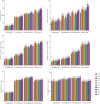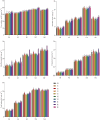By promoting growth and development, castor bean meal biofertilizer improves the yield and quality of Tartary buckwheat and indirectly improves the growth and development of Tartary buckwheat sprouts
- PMID: 40538872
- PMCID: PMC12176884
- DOI: 10.3389/fpls.2025.1584608
By promoting growth and development, castor bean meal biofertilizer improves the yield and quality of Tartary buckwheat and indirectly improves the growth and development of Tartary buckwheat sprouts
Abstract
Introduction: Fertilizer selection and application is closely related to crop yield and quality. Tartary buckwheat is a medicinal and food crops, has a broad space for development. However, the effect of castor bean meal biofertilizer on the growth and development, yield and quality of Tartary buckwheat and Tartary buckwheat buds is not clear. The aim of this study was to elucidate the effect of castor bean meal biofertilizer on Tartary buckwheat yield and quality, and then to elucidate the effect of castor bean meal biofertilizer indirectly on Tartary buckwheat bud yield and quality.
Methods: Tong buckwheat 3 as the test material, in 2 years of field trials, no fertilizer, chemical fertilizer and cow manure as a control, a total of 10 types of fertilizer treatment, respectively, CK (0 kg·ha-1), F1, F2, F3 (fertilizer, 225, 300, 375kg·ha-1); N1, N2, N3 (cow manure, 7500, 15000, 22500kg·ha-1); B1, B2, B3(Castor bean meal biofertilizer, 7500, 15000, 22500kg·ha-1).
Results: (1) under different fertilizer treatments, Tartary buckwheat plant height, stem thickness, the number of main stem nodes, the number of main stem branches, leaf area and chlorophyll content; single plant grain weight, thousand grain weight and yield of castor bean meal biofertilizer treatment is good, and in the B2 treatment to reach the maximum value. (2) under different fertilizer treatments, Tartary buckwheat protein, starch, cellulose, fat, flavonoid fractions and bioflavonoids are B2 treatment when the highest content. (3) Different fertilization treatments of Tartary buckwheat cultivated Tartary buckwheat buds bud length, fresh weight and dry weight there are significant differences. Tartary buckwheat buds in the 0-16d free amino acids, soluble sugars, total phenols, vitamin C and bioflavonoids content of Tartary buckwheat seeds in the B2 treatment of Tartary buckwheat cultivated Tartary buckwheat buds of the best indicators.
Discussion: In short, this study provides a new fertilization option to improve Tartary buckwheat yield and quality.
Keywords: Tartary buckwheat; Tartary buckwheat sprouts; castor bean meal biofertilizer; quality; yield.
Copyright © 2025 Mingjing, Xuemei, Rui, Chunhua, Ruimei, Guibin, Guorui, Jianjun, Cheng, Xiaohui, Zhimin, Ruxin, Yong and Fenglan.
Conflict of interest statement
Author XG was employed by the company Beijing Zhongmin Sunshine Biotechnology Co. The remaining authors declare that the research was conducted in the absence of any commercial or financial relationships that could be construed as a potential conflict of interest.
Figures









References
-
- Ahmed U., Lin J. C. W., Srivastava G., Djenouri Y. (2021). A nutrient recommendation system for soil fertilization based on evolutionary computation. Comput. Electron Agr. 189, 106407. doi: 10.1016/j.compag.2021.106407 - DOI
-
- Bhunia S., Bhowmik A., Mallick R., Mukherjee J. (2021). Agronomic efficiency of animal-derived organic fertilizers and their effects on biology and fertility of soil: A review. Agronomy. 11, 823. doi: 10.3390/agronomy11050823 - DOI
-
- Çürük U., Işık M., Ferahoğlu E., Kırıcı S., Ortaş İ. (2020). Effect of organic and inorganic fertilizer applications on buckwheat yield and micro element nutrition. Turkish JAF Sci.Tech. 8, 145–149. doi: 10.24925/turjaf.v8isp1.145-149.4063 - DOI
LinkOut - more resources
Full Text Sources
Research Materials
Miscellaneous

